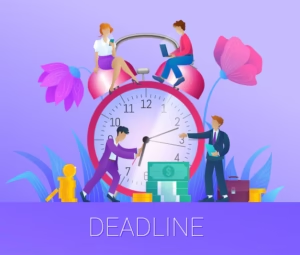8 Tips for Mastering Time Management

The Impact of Poor Time Management on Academic Performance
Effective time management is crucial for students aiming to achieve optimal academic performance. Conversely, poor time management can have significant negative repercussions that are detrimental to a student’s educational journey. One common issue that arises from ineffective time allocation is the inability to meet deadlines. Students may find themselves rushing to complete assignments at the last minute, which often results in subpar work that fails to reflect their true capabilities. According to a survey conducted by the American Psychological Association, over 60% of students reported that procrastination—often linked to poor time management—has a direct impact on their academic performance.
Additionally, the stress associated with managing time poorly can lead to anxiety and reduced motivation. When students fail to allocate their time wisely, they may experience an overwhelming workload that feels insurmountable. This, in turn, can contribute to significant mental health issues and affect their overall well-being. A study published in the Journal of College Student Development found that students who struggle with time management tend to report higher levels of stress and lower academic achievement, creating a vicious cycle that exacerbates both their academic and personal lives.
Moreover, the correlation between time management and grades is substantial. Data indicates that students who effectively prioritize their tasks and allocate sufficient time to study generally achieve higher grades. Conversely, those who do not manage their time well often see a decline in their academic performance. For instance, a student who consistently submits assignments late may receive penalized marks, while a peer who distributes their workload efficiently can maintain or enhance their GPA. In today’s fast-paced academic environment, mastering time management is not just an asset—it is a necessity for success.

Identifying Priorities: The Key to Effective Time Management
Effective time management is crucial for students aiming to achieve academic success while maintaining a balanced lifestyle. One fundamental aspect of managing time efficiently is the ability to identify and prioritize tasks. By distinguishing between what is urgent and important, students can allocate their time and energy more wisely, ultimately enhancing their productivity and reducing stress levels.
One practical approach to categorizing assignments and responsibilities is the Eisenhower Matrix, a tool developed by former U.S. President Dwight D. Eisenhower. This matrix divides tasks into four quadrants based on their urgency and importance. Quadrant one encompasses tasks that are both urgent and important, requiring immediate attention. For instance, preparing for an upcoming exam that is just around the corner would fall into this category. Quadrant two contains tasks that are important but not urgent, such as long-term projects or preparing for future assignments, which should be scheduled in advance to avoid last-minute rushes.
Quadrant three includes activities that are urgent but not important, often distractions demanding immediate action without contributing significantly to long-term goals. These could be interruptions like responding to certain emails or phone calls. Lastly, quadrant four pertains to tasks that are neither urgent nor important, which are candidates for elimination as they tend to waste valuable time. By utilizing the Eisenhower Matrix, students can make more informed decisions about where to focus their efforts, allowing them to prioritize their studies effectively.
In conclusion, mastering the skill of task prioritization is essential for students wishing to excel academically and manage their time effectively. The Eisenhower Matrix is a valuable tool in this regard, providing a clear framework that enables better decision-making. By adopting such strategies, students can enhance their productivity and academic performance while alleviating stress associated with poor time management.
Creating an Effective Daily Schedule
Developing a daily schedule is crucial for students aiming to balance academic commitments, personal responsibilities, and leisure activities. An effective schedule aids in managing time efficiently, showcasing how vital time management is for student success. To start, students should evaluate their daily responsibilities. This assessment allows them to identify critical tasks and obligations, which can then be categorized into academic, personal, and leisure activities.
Once responsibilities are outlined, the technique of time blocking comes into play. This involves allocating specific time slots for study sessions, classes, and other critical tasks. For instance, students could reserve the morning hours for intense study sessions, as their concentration levels are typically higher during this period. It is essential to maintain a balance within the schedule, ensuring that students do not overextend themselves. A well-structured schedule should include sufficient time for breaks, as regular pauses enhance productivity and prevent burnout.
Incorporating breaks is not simply beneficial; it is vital for maintaining focus and energy levels. For example, employing the Pomodoro Technique, which recommends studying for 25 minutes followed by a five-minute break, can be an effective strategy. During these breaks, students might engage in brief physical exercises, meditation, or even a quick snack, activities that refresh the mind and body.
Furthermore, flexibility is a key aspect of any daily schedule. Life can be unpredictable, so it is important for students to allow room for adjustments. Prioritizing tasks based on deadlines and importance will ensure that students remain on top of their studies without the added stress of last-minute cramming. By consistently reviewing and refining their daily schedules, students can optimize their time management strategies, ultimately leading to enhanced productivity and academic performance.

Using To-Do Lists and Calendar Apps
Effective time management is a critical skill for students, and utilizing to-do lists and calendar applications can significantly enhance organizational abilities. These tools serve as a systematic approach to tracking various tasks and deadlines, ensuring that important responsibilities do not get overlooked. By having a clear visual representation of what needs to be accomplished, students can prioritize their work and allocate sufficient time for each task.
To-do lists provide a straightforward way to outline daily or weekly objectives. Popular options such as Todoist, Microsoft To Do, and Any.do permit users to create tailored task lists, complete with due dates and priority levels. These apps often come equipped with features such as reminders and recurring tasks, which can further simplify the management of ongoing responsibilities. Incorporating these tools into a daily routine encourages accountability and fosters a sense of accomplishment as tasks are checked off the list.
On the other hand, calendar applications like Google Calendar, Apple Calendar, and Outlook are indispensable for scheduling and planning activities over a longer timeframe. By integrating deadlines, examinations, and social commitments within a single platform, students can better visualize their schedules. For optimal effectiveness, it is essential to routinely update the calendar and set notifications for crucial timelines. This ensures that students stay aware of upcoming obligations and can plan their study sessions effectively around them.
Incorporating both to-do lists and calendar apps into daily practices can lead to enhanced time management and overall academic success. The key lies in consistency and regular use. Hence, students should experiment with various applications to find the combination that best fits their workflow, ultimately leading to a more organized and productive academic experience.

Practicing with Timed Quizzes for Exam Readiness
In the landscape of academic success, practicing with timed quizzes emerges as a vital strategy for students aiming to refine their time management skills and enhance exam readiness. Implementing timed quizzes fosters a sense of urgency and encourages students to simulate authentic exam conditions. These quizzes serve as a tactile representation of the pressures associated with real exam environments, allowing students to acclimate to time constraints effectively.
Utilizing timed quizzes not only increases speed but also improves efficiency in answering questions, essential during tests where each moment counts. By engaging in this practice, students learn to prioritize questions based on their complexity and to allocate time judiciously, a cornerstone of effective time management. The exercise of racing against the clock naturally instills a level of confidence that lessens anxiety, equipping students with the mental fortitude required during actual exams.
To incorporate timed quizzes into study routines, students should allocate specific Zeitgeist times during their revision periods. For instance, embedding quizzes within traditional study blocks can create a balanced mix of content retention and practical application. Additionally, many educational platforms and resources provide pre-designed quizzes on various subjects; students can leverage these tools to structure their practice. Another effective method involves self-generated quizzes, empowering students to consolidate their understanding while creating materials that conform to their unique learning patterns.
Finally, students should review performance post-quiz to identify areas for improvement, which is crucial for refining their approach and tackling weaknesses. This iterative feedback loop ensures continuous growth and fortifies time management skills across different subjects. Through consistent practice with timed quizzes, students not only enhance their academic capabilities but also cultivate a disciplined approach to managing time, laying a foundation for lifelong learning success.
Successful Time Management Routines: Real-Life Examples
Effective time management is a crucial skill for students striving to excel in both academic and extracurricular activities. Different students adopt various routines based on their unique needs and goals, illustrating that there is no one-size-fits-all approach. One prominent example is that of Sarah, a university sophomore majoring in biology. Sarah utilizes a time-blocking technique, allocating specific hours of her day for studying, attending classes, and participating in extracurricular activities. By focusing on one task at a time, she maintains her concentration and efficiency, helping her achieve high marks while also dedicating time to her role in the environmental club.
Similarly, John, a high school senior, opts for a combination of digital and traditional planning tools. He employs a digital calendar to keep track of deadlines and class schedules while also using a physical planner for daily tasks. This hybrid method allows John to visualize his week effectively, ensuring he balances his academic responsibilities with pre-existing commitments such as soccer practice and volunteer work. His routine includes a dedicated time for homework each evening, preventing last-minute cramming before exams and allowing for better retention of the material learned.
Another inspiring example is Mia, a college freshman who practices the two-minute rule. If a task will take two minutes or less, she processes it immediately instead of postponing it. Mia finds that this approach significantly reduces her workload, making her days feel less overwhelming. Additionally, she sets aside intentional breaks during study sessions to recharge. By incorporating short relaxation periods, Mia enhances her focus and productivity throughout the day.
These routines highlight that successful time management requires personal adaptation and commitment. By examining the effective practices of these exemplary students, others can find inspiration to develop their own strategies that cater to their unique circumstances, thus maximizing their efficiency and well-being.
Overcoming Procrastination: Techniques to Stay Focused
Procrastination is a prevalent challenge among students, often leading to increased stress and reduced academic performance. To combat this issue effectively, several strategies can be employed. One practical method is to set small, achievable goals. Breaking down larger tasks into manageable segments allows students to experience a sense of accomplishment as they complete each part, thereby fostering motivation to continue. For instance, instead of aiming to write an entire research paper in one sitting, students could focus on completing just the introduction or one section at a time.
Another effective technique is the Pomodoro Technique, which advocates for structured study sessions followed by brief breaks. This method involves working for a concentrated interval, typically 25 minutes, followed by a 5-minute pause. After completing four cycles, a more extended break of 15 to 30 minutes is taken. This approach not only enhances focus but also helps in managing fatigue. By dedicating a short, intense focus period to a specific task, students can improve their productivity while minimizing the urge to procrastinate.
Moreover, creating an organized and distraction-free workspace is crucial for remaining focused. A cluttered environment can lead to distractions and hinder concentration. Students should aim to find a comfortable and quiet area to study, equipped with all necessary materials. Eliminating external distractions, such as mobile devices or social media notifications, can significantly enhance focus during study sessions. By implementing these techniques, students can develop a more disciplined approach to their studies, ultimately overcoming procrastination and better managing their time.
The Importance of Regular Reflection and Adjustment
Effective time management is an ongoing process that requires regular reflection and adjustment. For students, it is crucial to periodically assess the strategies they employ to manage their time. This reflection allows individuals to identify areas of strength and weakness in their current practices. By systematically evaluating what works and what does not, students can make the necessary modifications to optimize their productivity.
One meaningful approach to this reflection is to maintain a time management journal. In this journal, students can document their daily activities, noting how much time is allocated to studying, assignments, and leisure activities. By analyzing this data over a week or a month, students can gain insights into their routines, pinpointing tasks that consume excessive time or areas where inefficiencies exist. This level of awareness is a key component of effective time management.
Moreover, it is important for students to remain flexible in their approach. Life circumstances can change rapidly, and what may have worked at one point in time may no longer be effective. For example, if a student finds that they are consistently spending more time on assignments than they intended, they may need to adjust their study methods or alter their schedules. Being open to change and willing to adapt is fundamental to mastering time management.
In conclusion, the importance of regular reflection and adjustment in time management cannot be overstated. By fostering a habit of assessing productivity and making informed adjustments to their routines, students are better equipped to succeed academically while maintaining a healthy work-life balance. By continuously refining their approach to time management, they set themselves up for long-term success and personal growth.
Conclusion: The Long-Term Benefits of Mastering Time Management
Mastering time management is a crucial skill that extends far beyond the academic realm. The ability to effectively manage time is not only significant for improving academic performance but also lays the foundation for success in personal and professional endeavors. Students who develop strong time management capabilities are often better equipped to handle the demands of their educational journey, allowing them to submit assignments punctually, study efficiently, and balance extracurricular activities. This positive cycle of productivity enhances their overall academic achievement.
Moreover, the benefits of mastering time management continue to resonate long after students have graduated. In a professional setting, the skills acquired through effective time management facilitate improved project management, team collaboration, and prioritization of tasks. Individuals who can organize their workload efficiently often find themselves with increased job satisfaction and reduced stress levels, leading to healthier work-life balance. Such individuals are typically viewed by employers as assets to their organizations due to their ability to meet deadlines and adapt to changing circumstances.
In the personal sphere, the ability to manage time effectively allows for more meaningful engagements with family and friends, as well as the opportunity to pursue hobbies and interests. By allocating time intentionally, individuals can cultivate a well-rounded life that includes both productivity and leisure. In various life stages, whether in school, at work, or in retirement, the commitment to honing time management skills cultivates discipline and resilience, qualities that are essential for achieving long-term goals.
In conclusion, the long-term benefits of mastering time management encompass not only improved academic outcomes but also the development of essential skills that are invaluable in all areas of life. By investing time into learning and refining these skills, students prepare themselves for future challenges, ensuring that they can navigate both personal and professional landscapes with confidence and ease.
